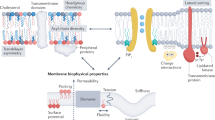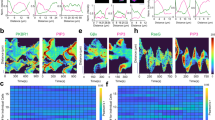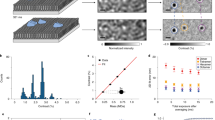Abstract
Lateral heterogeneities in the classical fluid-mosaic model of cell membranes are now envisaged as domains or ‘rafts’ that are enriched in (glyco)sphingolipids, cholesterol, specific membrane proteins and glycosylphosphatidylinositol (GPI)-anchored proteins1. These rafts dictate the sorting of associated proteins and/or provide sites for assembling cytoplasmic signalling molecules2. However, there is no direct evidence that rafts exist in living cells3,4. We have now measured the extent of energy transfer between isoforms of the folate receptor bound to a fluorescent analogue of folic acid, in terms of the dependence of fluorescence polarization on fluorophore densities in membranes5. We find that the extent of energy transfer for the GPI-anchored folate-receptor isoform is density-independent, which is characteristic of organization in sub-pixel-sized domains at the surface of living cells; however, the extent of energy transfer for the transmembrane-anchored folate-receptor isoform was density-dependent, which is consistent with a random distribution. These domains are likely to be less than 70 nm in diameter and are disrupted by removal of cellular cholesterol. These results indicate that lipid-linked proteins are organized in cholesterol-dependent submicron-sized domains. Our methodology offers a new way of monitoring nanometre-scale association between molecules in living cells.
This is a preview of subscription content, access via your institution
Access options
Subscribe to this journal
Receive 51 print issues and online access
$199.00 per year
only $3.90 per issue
Buy this article
- Purchase on Springer Link
- Instant access to full article PDF
Prices may be subject to local taxes which are calculated during checkout




Similar content being viewed by others
References
Jacobson, K., Sheets, E. D. & Simson, R. Revisiting the fluid mosaic model of membranes. Science 268, 1441–1442 (1995).
Simons, K. & Ikonen, E. Functional rafts in membranes. Nature 387, 569–570 (1997).
Harder, T. & Simons, K. Caveolae, DIGs, and the dynamics of sphingolipid–cholesterol microdomains. Curr. Opin. Cell Biol. 9, 534–542 (1997).
Weimbs, T., Hui-Low, S., Chapin, S. J. & Mostov, K. E. Apical targeting in polarized cells: there's more afloat than rafts. Trends Cell Biol. 7, 393–399 (1997).
Weber, G. Dependence of polarization of the fluorescence on the concentration. Trans. Faraday Soc. 50, 552–555 (1954).
Edidin, M. Lipid microdomains in cell surface membranes. Curr. Opin. Struct. Biol. 7, 528–532 (1997).
Brown, R. E. Sphingolipid organization in biomembranes: what physical studies of model membranes reveal. J. Cell Sci. 111, 1–9 (1998).
Kurzchalia, T. V., Hartmann, E. & Dupree, P. Guilt by insolubility—does a protein's detergent insolubility reflect a caveolar location? Trends Cell Biol. 5, 187–189 (1995).
Mayor, S. & Maxfield, F. R. Insolubility and redistribution of GPI-anchored proteins at the cell surface after detergent treatment. Mol. Biol. Cell 6, 929–944 (1995).
McConville, M. J. & Ferguson, M. A. The structure, biosynthesis and function of glycosylated phosphatidylinositols in the parasitic protozoa and higher eukaryotes. Biochem. J. 294, 305–324 (1993).
Mayor, S., Rothberg, K. G. & Maxfield, F. R. Sequestration of GPI-anchored proteins in caveolae triggered by cross-linking. Science 264, 1948–1951 (1994).
Parton, R. G., Joggerst, B. & Simons, K. Regulated internalization of caveolae. J. Cell Biol. 127, 1199–1215 (1994).
Fujimoto, T. GPI-anchored proteins, glycosphingolipids, and sphingomyelin are sequestered to caveolae only after crosslinking. J. Histochem. Cytochem. 44, 929–941 (1996).
Brown, D. The tyrosine kinase connection: how GPI-anchored proteins activate T cells. Curr. Opin. Immunol. 5, 349–354 (1993).
Griffiths, G. Fine Structure Immunochemistry 1–459 (Springer, Heidelberg, (1993)).
Simson, R.et al. Structural mosaicism on the submicron scale in the plasma membrane. Biophys. J. 74, 297–308 (1998).
Sheets, E. D., Lee, G. M., Simson, R. & Jacobson, K. Transient confinement of a glycosylphosphatidylinositol-anchored protein in the plasma membrane. Biochemistry 36, 12449–12458 (1997).
Kenworthy, A. K. & Eddin, M. Searching for ‘lipid rafts’ in cell membranes using fluorescence resonance energy transfer (FRET) microscopy. Biophys. J. 74, A8 (1998).
Matko, J. & Edidin, M. Energy transfer methods for detecting molecular clusters on cell surfaces. Meth. Enzymol. 278, 444–462 (1997).
Hannan, L. A., Lisanti, M. P., Rodriguez-Boulan, E. & Edidin, M. Correctly sorted molecules of a GPI-anchored protein are clustered and immobile when they arrive at the apical surface of MDCK cells. J. Cell Biol. 120, 353–358 (1993).
Runnels, L. W. & Scarlata, S. F. Theory and application of fluorescence homotransfer to melittin oligomerizaiton. Biophys. J. 69, 1569–1583 (1995).
Cerneus, D. P., Ueffing, E., Posthuma, G., Strous, G. J. & van der Ende, A. Detergent insolubility of alkaline phosphatase during biosynthetic transport and endocytosis. Role of cholesterol. J. Biol. Chem. 268, 3150–3155 (1993).
Hanada, K., Nishijima, M., Akamatsu, Y. & Pagano, R. E. Both sphingolipids and cholesterol participate in the detergent insolubility of alkaline phosphatase, a glycosylphosphatidylinositol-anchored protein, in mammalian membranes. J. Biol. Chem. 270, 6254–6260 (1995).
Taraboulos, A.et al. Cholestrol depletion and modification of COOH-terminal targeting sequence of the prion protein inhibit formation of the scrapie isoform. J. Cell Biology. 129, 121–132 (1995).
Chang, W.-J., Rothberg, K. G., Kamen, B. A. & Anderson, R. G. W. Lowering cholesterol content of MA104 cells inhibits receptor-mediated transport of folate. J. Cell Biol. 118, 63–69 (1992).
Mayor, S., Sabharanjak, S. & Maxfield, F. R. Cholesterol-dependent retention of GPI-anchored proteins in endosomes. EMBO J.(in the press).
Stulnig, T. M.et al. Signal transduction via glycosyl phosphatidylinositol-anchored proteins in T cells is inhibited by lowering cellular cholesterol. J. Biol. Chem. 272, 19242–19247 (1997).
Yancey, P. G.et al. Cellular cholesterol efflux mediated by cyclodextrins. Demonstration of kinetic pools and mechanism of efflux. J. Biol. Chem. 271, 16026–16034 (1996).
Ritter, T. E., Fajardo, O., Matsue, H., Anderson, R. G. & Lacey, S. W. Folate receptor targeted to clathrin-coated pits cannot regulate vitamin uptake. Proc. Natl Acad. Sci. USA 92, 3824–3828 (1995).
Friedrichson, T. & Kurzchalia, T. V. Microdomains of GPI-anchored proteins in living cells revealed by crosslinking. Nature 394, 802–805 (1998).
Matter, K., Hunziker, W. & Mellman, I. Basolateral sorting of LDL receptor in MDCK cells: the cytoplasmic domain contains two tyrosine-dependent targeting determinants. Cell. 71, 741–753 (1992).
Acknowledgements
We thank M. K. Mathew and G. Krishnamoorthy for their insight, F. Barrantes, A. K. Menon and J. Udgaonkar for critical reading of the text, S. Chitkala and N. S. Kiran for making the FR-TM construct, and R. Priya for help with cholesterol analysis. S.M. thanks the Human Frontier Science Program and the National Centre for Biological Sciences for support, and F. F. Bosphorus for inspiration.
Author information
Authors and Affiliations
Corresponding author
Rights and permissions
About this article
Cite this article
Varma, R., Mayor, S. GPI-anchored proteins are organized in submicron domains at the cell surface. Nature 394, 798–801 (1998). https://doi.org/10.1038/29563
Received:
Accepted:
Issue Date:
DOI: https://doi.org/10.1038/29563
This article is cited by
-
Mechanisms and roles of podosomes and invadopodia
Nature Reviews Molecular Cell Biology (2023)
-
Two aspartic proteases, BnaAP36s and BnaAP39s, regulate pollen tube guidance in Brassica napus
Molecular Breeding (2023)
-
Biocompatible and optically stable hydrophobic fluorescent carbon dots for isolation and imaging of lipid rafts in model membrane
Analytical and Bioanalytical Chemistry (2022)
-
Determination of G-protein–coupled receptor oligomerization by molecular brightness analyses in single cells
Nature Protocols (2021)
-
Fluorescence-based techniques for the detection of the oligomeric status of proteins: implication in amyloidogenic diseases
European Biophysics Journal (2021)
Comments
By submitting a comment you agree to abide by our Terms and Community Guidelines. If you find something abusive or that does not comply with our terms or guidelines please flag it as inappropriate.



